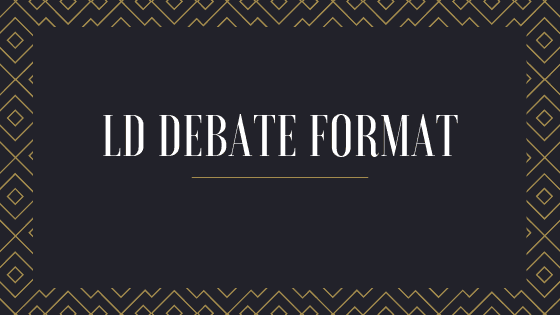Lincoln/Douglas Debate Format
Short introduction of the LD debate format:
Number of people in the debate: 2
Number of people in a team: 1
Number of teams in the debate: 2
Duration of the speeches: The times are different from speech to speech, and are marked at the speeches
Questions format: Cross-examination
This debate format derives directly from the US Presidential debates. It is a bit different, especially from the timing of the speeches. The debate format is used in the US High School debates.
LD Debate format explained
1st Affirmative constructive – 7 minutes
This is your place to shine, you need to have a nice opening of the debate and introduction that will wake up the judges. You need to clearly explain what are the important parts (arguments) of your speech. For each of them, you need to show the title, explanation and the support, statistics or quote important people that agree with you.
Cross-examination – negative asks affirmative – 3 minutes
Ask questions that will help you open your new arguments or new support lines, make if obvious how the points that you are asking are connected to the topic. Be brave and direct. You and your opponents should face the audience when asking and answering questions, you don’t look at each other.
When you are answering the questions you really try to answer questions. If you feel you are getting tricked into an answer, tell that and tell why. But don’t try to avoid answering if you are not really sure that it will hurt you.
1st Negative constructive – 8 minutes
The one and only negative constructive, and you have a lot of time. Take 3 minutes to reply to all the most important points that were shown on the aff side, tell the judges why they are wrong, what supports that they have are wrong and why their argumentative logic is false.
After 3 minutes stop and start with your constructive material. Announce all the arguments that you will have in advance and clearly explain every argument that you have.
Cross-examination – affirmative asks negative – 3 minutes
Now follow the so-called rebuttal speeches. The debaters should not present new arguments but are allowed to present new evidence.
1st Affirmative rebuttal – 4 minutes
You respond to the things that were said on the negative side of the debate. You are the first and the only speaker that will respond to the negative constructive speech, so this is really important. Throughout the speech, you should try to rebuild your affirmative arguments if needed, but don’t bring new arguments or parts of arguments, you are only allowed to bring in new evidence that will support your affirmative material.
1st Negative rebuttal – 7 minutes
First, you need to reply to the things that were said in the 1st aff rebuttal. You can do that separate on a point-by-point basis, or you can include that into your summation of all the important things that have been said in the debate. You have 7 minutes, so you should have enough time to do that.
When you sum up the whole debate you need to show what are the biggest problems in the debate (on the aff side, of course) and what are the biggest wins in the debate (presumably on your side).
2nd Affirmative rebuttal – 4 minutes
You sum up the debate and show the clashes that were the most important in this debate. You only have 4 minutes to speak, so you better make it good 😀
How to learn LD debate
There are several ways how to do it, but the best one is a combination of regular debate meetings and a private coach. If you are looking for a private debate coach, check out our LD debate coach page.

Hey, my name is Peter and I’m the author of this website and all the content on this page. I have been a debater, a debate trainer, debate tournament organizer and everything else with a debate prefix for more than 10 years and I’ve seen it all. I want to help everyone to be a better debater and if you want to help too, please let me know. Keep on debating!

